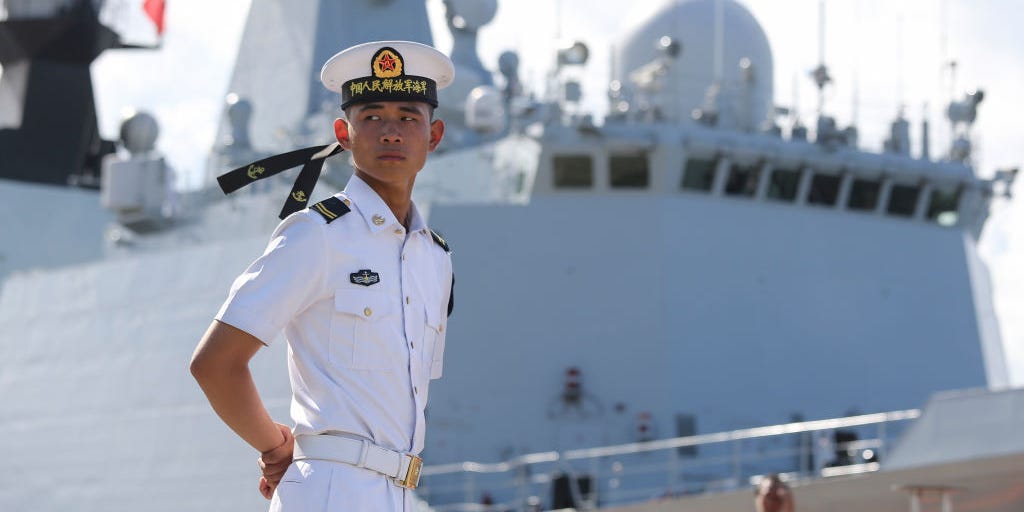
Photo by Dickson Lee/South China Morning Post via Getty Images
- A new Department of Defense report on China’s military power said that China “has the largest navy in the world” and is “the top ship-producing nation in the world by tonnage.”
- Experts said that “their shipbuilding capacity is a huge advantage for them in a protracted conflict with the United States,” which lacks the same ability to quickly build new ships.
- With the ability to turn out ships faster than any other country, China could build up its force or rapidly replace its naval losses in a conflict.
- Visit Business Insider’s homepage for more stories.
China has an edge over the US in shipbuilding, and it could give the country an advantage in a protracted conflict in which both sides see heavy losses at sea, experts told Insider.
“China has already achieved parity with — or even exceeded — the United States in several military modernization areas,” the Pentagon reported recently, identifying shipbuilding as one area where China has an advantage.
“The [People’s Republic of China] has the largest navy in the world, with an overall battle force of approximately 350 ships and submarines including over 130 major surface combatants,” the Pentagon assessed in its latest China Military Power report.
The Pentagon also reported that “China is the top ship-producing nation in the world by tonnage,” adding that the country is currently striving to increase “its shipbuilding capacity and capability for all naval classes.”
And, as Andrew Erickson, a professor of strategy at the US Naval War College, noted in his analysis of the report, “quality is riding shotgun with quantity” as China builds new, more modern warships.
Among the surface combatants China is building are cruisers, destroyers, and corvettes, which the Department of Defense says "will significantly upgrade the PLAN's air defense, anti-ship, and antisubmarine capabilities."
China is also continuing to build support ships, amphibious warfare vessels, and aircraft carriers for expeditionary operations and power projection.
Modern warfare is complicated, with many different factors contributing to a conflict's outcome, but with the ability to produce ships faster than any other country, China could build up its force or rapidly replace its naval losses in a conflict, much as the US was able to do during World War II.
The US does not have that same shipbuilding capacity today, in part, because the US focuses on building more advanced assets at a handful of specialized shipyards, but also because the US is not that same industrial power.
Although the US Navy — with a battle force of 293 ships — is the most powerful navy in the world, military leaders have expressed concerns about America's decreased ability to rapidly build new ships.
Gen. David Berger, the commandant of the Marine Corps, assessed recently that "replacing ships lost in combat will be problematic, inasmuch as our industrial base has shrunk, while peer adversaries have expanded their shipbuilding capacity."
"In an extended conflict, the United States will be on the losing end of a production race—reversing the advantage we had in World War II when we last fought a peer competitor," Berger wrote in a draft report on operational concepts obtained by Breaking Defense.

Xinhua/Jiang Shan via Getty Images
'A huge advantage'
China's ability to quickly build ships stems from its efforts to build a modern navy. The US, on the other hand, has the advantage of already fielding a modern navy that deploys around the world.
"China can produce ships very fast. There is absolutely no doubt about that," Matthew Funaiole, a senior fellow with the China Power Project at the Center for Strategic and International Studies, told Insider, calling China's shipbuilding capacity"impressive."
But, he explained, "China is in the process of developing its first real, modern navy, so it has a lot of catching up to do, whereas the US already has a modern navy."
While the Chinese People's Liberation Army Navy has more vessels than the US Navy, it has not yet achieved parity. But the less advanced nature of its force and its shipbuilding capacity give it an edge, to a certain extent, in a protracted conflict.
In a conflict, the US Navy would have better pieces on the board, but it is unlikely to receive many new pieces during the course of the fight. The same is likely not true for China, meaning that a loss is felt potentially more heavily by the US.
"Their shipbuilding capacity is a huge advantage for them in a protracted conflict with the United States," Bryan Clark, a former US Navy officer and defense expert at the Hudson Institute, told Insider.
"They have multiple shipyards building every class of ship, which is not really the case in the US Navy," he said. "It gives them some extra capacity if they need to do a buildup or ramp-up of the navy or rebuild the navy in a conflict where they lose a lot of ships."
One large question mark when looking at China's naval ambitions is maintenance capacity, the ability to repair ships damaged in combat.
"Their maintenance capacity is not as significant as their shipbuilding capacity," Clark said. "Because their fleet is relatively new, they have not had to generate the kind of repair capacity that the US Navy has."
As China continues to expand the world's largest navy, how the country will maintain that expanded force is a problem it will have to address.
"There's so much cost to maintaining vessels," Funaiole said. "Building them is a big cost upfront, but keeping them battle ready, keeping them in good standing order, that costs a lot of money, and it becomes more expensive over time."
Erickson, the Naval War College expert, explained in his analysis that "China's maintenance capacity has not been tested in volume yet, but seems competent so far."
"Whether China can continue to implement its maintenance plan effectively when midlife ship deadlines trigger massive increases in capacity requirements over the next few years remains to be seen," he noted.
The US has long been a leading naval power, but the US Navy has its fair share of troubling maintenance issues. For example, a recent Government Accountability Office report said that between fiscal years 2015 and 2019, 75 percent of planned maintenance for the service's aircraft carriers and submarines was completed late.
The US and China "are more evenly matched when it comes to ship maintenance capacity," Clark said.
Of course, there is more to war than shipbuilding. When talking about a protracted conflict where both sides are taking losses, many other factors come into play that could make the shipbuilding capacity of each state less relevant.
"What kind of prolonged conflict in which the US is sustaining naval losses doesn't escalate into other types of conflict? What is the US response if it lost [an aircraft] carrier or something like that?" Funaiole asked.
"It is an unpleasant thing to think about," he said, "but I think we'd be getting into territory where US shipbuilding capacity is probably not the biggest concern at that point."

